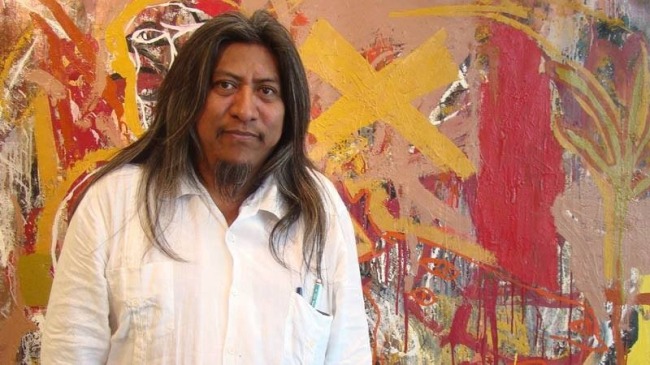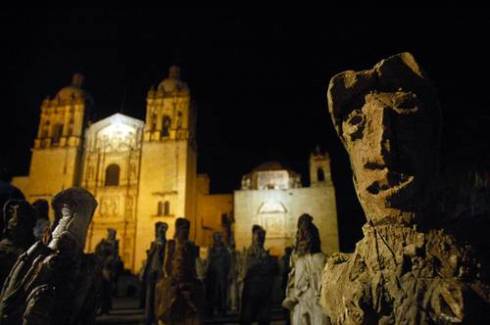Artists have an advantage when they die. Their work, particularly if they’re successful, preserves their legacy. They don’t have to rely on a loved one dragging out a family photo album to remind grandchildren of their existence. I know this and yet I’m still deeply saddened by the passing yesterday of my favorite artist, the Oaxacan painter and sculptor Alejandro Santiago.
Longtime readers of my blogs will remember my unsuccessful pilgrammage to find the depopulated village he immortalized in his Migrante project, and my elation at winning best screenplay at the Oaxacan International Film Festival because the prize was a statue by Santiago.
On the night of the awards ceremony, I didn’t get to meet Santiago because he was still making the trip back from Mexico City where the statues were cast into bronze. But later the film festival organizers took me to his home, where I met his wife and his grandmother – who still sews and sells traditional women’s blouses at the market in Oaxaca. Most of the migrante statues that made Santiago famous are in private collections and museums around the world, but a few hundred were landscaped into the courtyard of his modest house as though they’d just climbed over his wall and taken shelter.
I could write about how Santiago’s work should be a metaphor for policy change, a protest against the ideological divide in this country concerning immigration. His sculptures could symbolize the hypocrisy of the United States — self-proclaimed moral compass for human rights — building a wall to keep other human beings away from our stuff.
But I don’t think that’s what Alejandro Santiago would have wanted. He would have wanted to keep it personal. That’s why his statues of migrantes are so achingly moving. Each one was inspired by a battered, imperfect, unfinished person who was willing to lose everything for the chance at a better life.
Santiago flipped the narrative. While our Congressional representatives are obsessed with painting immigrants as a threat to our security and jobs, Santiago painted the reality of immigration. Contrary to the ethnocentric assumption that Mexican immigrants come from nothing and want a handout, I have found them to be devastated at having to leave their own rich culture and become invisible in ours. They leave because of poverty, yes, but they leave behind a wealth of family, connection and heritage. They lose the place where they belong and their absence is a gaping hole filled with the tears of mothers and children left behind.
Santiago is now part of that absence – taken too soon. Oaxaca lost its most grounded ambassador, the native son who sang its story to the world. He was famous enough to live anywhere he wanted, could have traded on his talent and exotic charisma. But he came back home to hire and train other indigenous artists in Oaxaca. He came back home to support independent film and documentaries. He came back home to live beside his grandmother and her sewing machine.


Reblogged this on "Womenisms" and commented:
An artistic legacy
A moving tribute, Teresa. I just read it (7:15 tues.), otherwise I’d have said something on the phone. Glad you put his story/significance out there. Q
T.- I remember well your joy in receiving the statuette, and my own surprise that Santiago had created them. To your own personal sense of loss I’ll add my condolences to the arts communities and cultural communities and liberation communities to whom he was intimately iconic. “Don’t mourn; organize.”